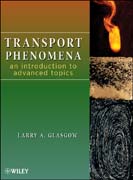
This is an advanced-level book in which prior exposure to transport phenomenais assumed. Familiarity with the classic, Transport Phenomena, 2nd Edition, by R. B. Bird, W. E. Stewart, and E. N. Lightfoot (BS one can learn a great deal by obtaining a historical perspective and in many instances this has been provided. The book purposefully avoids significant use of commercial software for problem solutions. The author considers such packages as tools, sometimes asnecessary evils. But the typical student tendency to treat such programs as magic black boxes guarantees that their use will contribute little to student understanding of transport phenomena (let alone how the governing partial differential equations might actually be solved). Since 1980 the increases in PC capability have been astonishing; it now appears that Moores law (the number of transistors on an integrated circuit yielding minimum component cost doubles every 24 months) may continue to hold true through several more generations of chip development. In addition, PC hard-drive capacity has exhibited exponential growth over that time frame and the estimated cost per G-FLOP has decreased by a factor of about 3 every year for the last decade. It is not an exaggeration to say that a cheap desk-top PC in 2008 has much more computing power than a typical university mainframe computer of 1970. Thus, problems that were oncepedagogically impractical should now be routine. This computational revolution has changed the way the author approaches instruction in transport phenomenaand it has made it possible to assign more complex exerciseseven embracing nonlinear problemsand still maintain expectations of timely turn-around of student work. The authors intent was that this computational revolution be reflected in this book (and in some of the problems that accompany it). At the same time, the author feels that tying this course of study to a particular piece of commercial software would be an egregious mistake. Cultivating understanding of how a solution is to be obtained is much more valuable instructionally than merely obtaining a solution. The author has tried to share his enthusiasm for the subject, and develop a passion in the reader by demonstrating that transport phenomena are pervasive and that they affect every aspect of life. This bookby its approachsteers the reader away from rote learning, which is ineffective in this subject area. The successful application of transport phenomena to new and unanticipated problems is really about physical understanding and problem-solving capability. For example, in 1960 (the year of birth for transport phenomena as a field of study) few engineers would have grasped the significance of chemical vapor deposition to the production of solid-state devices. Yet, the principles of transport phenomena apply fully to this operation and have been used around the world to improve its efficiency. This book will demonstrate to the reader how mastery of this subject will facilitate evaluation of manyphysical phenomena, processes, and systems, across many disciplines. Since noone book can cover this complex field totally, there are many places in the text where outside reading and additional study are recommended.
- ISBN: 978-0-470-38174-8
- Editorial: John Wiley & Sons
- Encuadernacion: Cartoné
- Páginas: 280
- Fecha Publicación: 09/07/2010
- Nº Volúmenes: 1
- Idioma: Inglés
